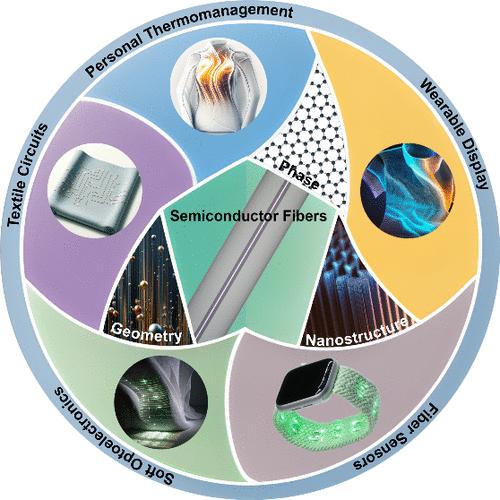当前位置:
X-MOL 学术
›
Acc. Mater. Res.
›
论文详情
Our official English website, www.x-mol.net, welcomes your
feedback! (Note: you will need to create a separate account there.)
Thermally Drawn Semiconductor Fibers: Fabrication Strategies and Applications
Accounts of Materials Research ( IF 14.0 ) Pub Date : 2024-09-28 , DOI: 10.1021/accountsmr.4c00132 Zhixun Wang, Lei Wei
Accounts of Materials Research ( IF 14.0 ) Pub Date : 2024-09-28 , DOI: 10.1021/accountsmr.4c00132 Zhixun Wang, Lei Wei

|
Wearable electronics enable seamless incorporation of electronics into our daily lives. Consumer-grade wearables, such as smart rings, bands, and watches, have gained popularity in recent years due to their capacity to offer consistent and dependable data collection and assistance for daily activities. Moreover, wearable electronics are emerging in professional medical services, such as continuous glucose monitoring and minimally invasive thrombectomy, to aid healthcare professionals in diagnosing and treating. In addition, the proliferation of the Internet of Things (IoT) has further fueled the demand for wearable electronics, as they are the critical components for an IoT system to support the sharing and analysis of data across multiple devices and platforms. The market for wearable electronics predictably continues to expand in the future. Semiconductors are crucial components of wearable electronics, and especially in fiber form factor, they enable monolithic fiber electronics and smart textiles. Several techniques are developed for fabricating inorganic semiconductor fibers, such as the Czochralski growth method, micropulling-down process, and thermal drawing technique. Thermal drawing of semiconductor fibers is a technique in which semiconductor materials are supported by glassy cladding materials and heated into fluid melts, with the combination drawn to fiber dimensions. Among the various fabrication methods, the thermal drawing technique has the advantages of a high yield rate, feasible integration of multiple materials, the capability of achieving designable sophisticated structures, and an extended single-strand fiber length. The as-drawn semiconductor fibers may serve as the building blocks of wearable electronics directly or subject to postprocessing procedures for on-demand alteration of dimension, geometry, or phase structure before employment. Research efforts within the fundamental understanding of fluid dynamics, rheology, and molecular structure evolution seek to improve the performance and quality of thermally drawn semiconductor fibers such as conductivity, bandgap, electron mobility, thermal stability, and mechanical strength. In this Account, we systematically recapitulate our efforts in developing semiconductor fibers and their application in wearable electronics, including diodes, sensors, energy harvesters, and more. We begin by introducing the three primary thermal drawing methods, highlighting the unique features of each. Next, postprocessing methods to further alter the materials, structures, and geometries of semiconductor fibers are discussed. We then discuss the various devices and applications and conclude with an examination of current challenges and our perspectives on future research directions. This Account aims to inspire further research efforts to expand the scope of fiber materials, the design of in-fiber structures, and configurations of device assembly to achieve widespread adoption of semiconductor fibers in various fields.
中文翻译:

热拉制半导体纤维:制造策略和应用
可穿戴电子产品使电子产品能够无缝融入我们的日常生活。消费级可穿戴设备,如智能戒指、手环和手表,近年来越来越受欢迎,因为它们能够为日常活动提供一致且可靠的数据收集和帮助。此外,可穿戴电子设备正在专业医疗服务中兴起,例如连续血糖监测和微创血栓切除术,以帮助医疗保健专业人员进行诊断和治疗。此外,物联网 (IoT) 的普及进一步推动了对可穿戴电子产品的需求,因为它们是物联网系统的关键组件,支持跨多个设备和平台共享和分析数据。可以预见,可穿戴电子产品市场在未来将继续扩大。半导体是可穿戴电子产品的关键组件,尤其是纤维外形尺寸,它们支持单片纤维电子产品和智能纺织品。开发了几种用于制造无机半导体纤维的技术,例如 Czochralski 生长法、微下拉工艺和热拉技术。半导体纤维的热拉拔是一种技术,其中半导体材料由玻璃包层材料支撑并加热成流体熔体,组合拉出纤维尺寸。在各种制造方法中,热拉丝技术具有良率高、多种材料的可行集成、能够实现可设计的复杂结构以及延长单股纤维长度等优点。 拉制半导体纤维可以直接用作可穿戴电子设备的构建块,也可以在使用前根据需要更改尺寸、几何形状或相结构的后处理程序。在对流体动力学、流变学和分子结构进化的基本理解下,研究工作旨在提高热拉制半导体纤维的性能和质量,例如电导率、带隙、电子迁移率、热稳定性和机械强度。在本专题中,我们系统地概括了我们在开发半导体光纤方面所做的努力及其在可穿戴电子产品(包括二极管、传感器、能量采集器等)中的应用。我们首先介绍三种主要的热绘图方法,重点介绍每种方法的独特功能。接下来,讨论了进一步改变半导体纤维的材料、结构和几何形状的后处理方法。然后,我们讨论了各种设备和应用,最后研究了当前的挑战和我们对未来研究方向的看法。本账户旨在激发进一步的研究工作,以扩大纤维材料的范围、纤维内结构的设计和器件组装的配置,以实现半导体纤维在各个领域的广泛采用。
更新日期:2024-09-28
中文翻译:

热拉制半导体纤维:制造策略和应用
可穿戴电子产品使电子产品能够无缝融入我们的日常生活。消费级可穿戴设备,如智能戒指、手环和手表,近年来越来越受欢迎,因为它们能够为日常活动提供一致且可靠的数据收集和帮助。此外,可穿戴电子设备正在专业医疗服务中兴起,例如连续血糖监测和微创血栓切除术,以帮助医疗保健专业人员进行诊断和治疗。此外,物联网 (IoT) 的普及进一步推动了对可穿戴电子产品的需求,因为它们是物联网系统的关键组件,支持跨多个设备和平台共享和分析数据。可以预见,可穿戴电子产品市场在未来将继续扩大。半导体是可穿戴电子产品的关键组件,尤其是纤维外形尺寸,它们支持单片纤维电子产品和智能纺织品。开发了几种用于制造无机半导体纤维的技术,例如 Czochralski 生长法、微下拉工艺和热拉技术。半导体纤维的热拉拔是一种技术,其中半导体材料由玻璃包层材料支撑并加热成流体熔体,组合拉出纤维尺寸。在各种制造方法中,热拉丝技术具有良率高、多种材料的可行集成、能够实现可设计的复杂结构以及延长单股纤维长度等优点。 拉制半导体纤维可以直接用作可穿戴电子设备的构建块,也可以在使用前根据需要更改尺寸、几何形状或相结构的后处理程序。在对流体动力学、流变学和分子结构进化的基本理解下,研究工作旨在提高热拉制半导体纤维的性能和质量,例如电导率、带隙、电子迁移率、热稳定性和机械强度。在本专题中,我们系统地概括了我们在开发半导体光纤方面所做的努力及其在可穿戴电子产品(包括二极管、传感器、能量采集器等)中的应用。我们首先介绍三种主要的热绘图方法,重点介绍每种方法的独特功能。接下来,讨论了进一步改变半导体纤维的材料、结构和几何形状的后处理方法。然后,我们讨论了各种设备和应用,最后研究了当前的挑战和我们对未来研究方向的看法。本账户旨在激发进一步的研究工作,以扩大纤维材料的范围、纤维内结构的设计和器件组装的配置,以实现半导体纤维在各个领域的广泛采用。






























 京公网安备 11010802027423号
京公网安备 11010802027423号